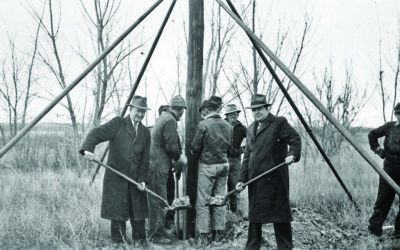
As a not-for-profit utility, Dawson PPD focuses on cost-effectively extending the life of its existing facilities while maintaining adequate levels of safety and reliability. Testing wooden poles helps the District ensure reliability and long life of its equipment, saving customers money in the long run.
Traditionally, pole testing involved a hammer for sounding, a shovel for digging around the base and drilling holes to test for decay. Today, Dawson PPD hires a contractor that uses a scientifically-based system called POLUX as a less-invasive and more accurate form of testing.
POLUX works by sending two, three inch long probes the size of an eight-penny nail into the base of the utility pole. This is the most vulnerable point where decay is most likely to occur on a pole. The probes measure resistance and moisture content of the pole. This information, along with the type of wood the pole is made of and how it was treated are run through a computer program with the pole’s GPS location recorded.
Typically, Dawson PPD uses a Southern Yellow Pine tree for its poles, which should have a resistance of 8,000 pounds per square inch when new. If the measurement falls below 50 percent of the recommended resistance, in this case 4,000 PSI, the pole is marked for replacement.
All of Dawson PPD’s poles are tested every 10 years on a rotating schedule with 10,000-11,000 poles tested annually.
OTHER NEWS
Working with birds of prey
When you think about hunting, you may imagine a person with a shotgun and his trusty dog by his side. Or, perhaps, an individual high in a tree stand with their bow. But what about an individual who hunts with a hawk? Falconry is the art of hunting with raptors like...
Between the lines: Is retail choice right for Nebraska?
By Gwen Kautz, Dawson PPD General Manager gkautz (at) dawsonpower.com 308-324-2386 Over the holidays, a report was published that claimed Nebraskan’s are not benefiting from the public power model in Nebraska and that introducing competition would garner lower rates....
Celebrating 80 years of service
On January 25, 1937, local farmers and other community leaders filed a petition with the Nebraska Department of Roads and Irrigation for the creation of Dawson County Public Power District. The District was officially formed February 26, 1937. The District put its...



